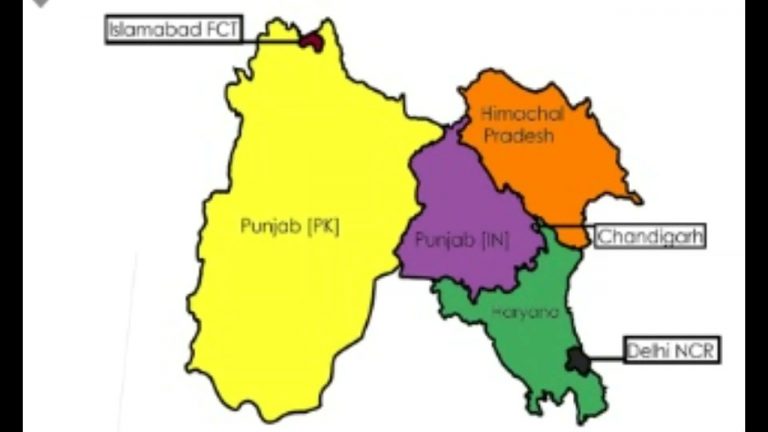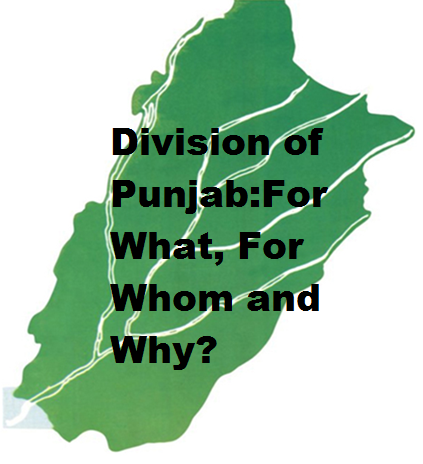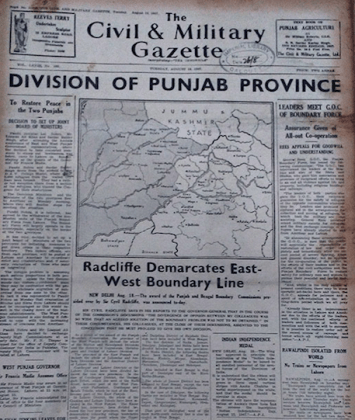
A look at events leading to and the aftermath of three different partitions of Punjab after the emergence of British rule
By Yadwinder Singh
The demand for the partition of the Punjab • Week after Lahore resolution, the Khalsa National Party of which Sir Sunder Singh Majithiya passes a resolution prophesying that “it would be the height of audacity for anyone to imagine that Sikhs would tolerate for a single day the undiluted communal raj of any community in the Punjab which is not only their homeland but also their holy land.” • Dec,2 1942 Master Tara Singh advocated the partition of Punjab into two provinces one dominated by Hindus and Sikhs and the other by the Muslims. • Shromani Akali Dal put forward the Azad Punjab Scheme. • According to scheme new Punjab was to carve out after separating the overwhelming Muslim majority areas, it was argued that it was to be an ideal province with about an equal portion of Hindus, Muslims and Sikhs. • Master Tara Singh had explained basis of province in his letter to Sir Stafford Cripps. • He said “the Sikh certainly cannot dominate any decently large portion of the country and hence they do not demand domination. But a big province, much bigger than many of existing provinces in area, population and wealth can certainly be carved out where Sikhs are dominated by no single minority.”
Mr. Jinnah’s rejection of partition proposal • Mahatma accepted the principle of division of the Punjab in a united India when he wrote to Mr. Jinnah saying “ I proceed on the assumption that India is not to be regarded as two or more nations but as one family consisting of many members, of whom the Muslim living in the north-west zones, i.e. Baluchistan, Sindh, north west frontier province and that part of Punjab where they are in an absolute majority over all other elements and in parts of Assam and Bengal where they are in an absolute majority, desire to live in separation from India……the areas should be demarcated by commission approved by the congress and the league. The wishes of the inhabitants of the areas demarcated should be asserted through votes of adult population of the areas or through some equivalent method. If the vote is in the favour of separation it shall be agreed that these areas shall form separate state as soon as possible after India is free from foreign domination.” • Jinnah rejected this proposal an replied “self-determination confined to Muslims alone • “we claim right of self- determination as nation… you are laboring under wrong idea that “self-determination” means only of a “territorial unit”… ours is the case of division and carving out two independent sovereign states by way of settlement between two major nation, Hindus and Muslims, and not of severance or secession from any existing Union”
 “The Conspicuous Part” by Dr. Mohammad Iqbal • Dr. Mohammad Iqbal at annual session of Muslim league was among first to suggest a separate Muslim state “ the formation of consolidated north west Indian Muslim state appears to me to be the final destiny of the Muslims.” • Dr. Mohammad Iqbal had been persuading the Muslims members of the unionist party to join Muslim league since 1936. • Due to this Jinnah got concerned and invited Sir Sikander Hayat Khan to Lucknow, to attend the session of the league in Oct. 1937 and hence the Sikander-Jinnah pact was signed which converted the Muslim members of the unionist party into members of Muslim league. • Sir Sikander Hayat Khan joining the league particularly at time when he had solid majority of 119 members in the house of 175 proved the beginning of the end of the unionist party of which he was leader. • Though Sir Sikander had joined the Muslims league, he had fundamental differences with Jinnah. • He resigned from Muslim league working committee in 1942, some months before his death. • In March 1944, Jinnah asked Sir Khizar Hayat Khan, to persuade all Non-Muslim members of the assembly to join Muslim League Collation. • Jinnah demanded that ministry in Punjab should be named Muslim League Collation Party. • Unionist Party leaders rejected these demands Muslim League members crossed over the opposition just before the dissolution of the assembly for the elections of 1946. • Meanwhile British Labor Ministry sent the Cabinet Mission whose plan was accepted both by Muslim League and congress. The existing Punjab Legislative Assembly was dissolved and new elections were held.
“The Conspicuous Part” by Dr. Mohammad Iqbal • Dr. Mohammad Iqbal at annual session of Muslim league was among first to suggest a separate Muslim state “ the formation of consolidated north west Indian Muslim state appears to me to be the final destiny of the Muslims.” • Dr. Mohammad Iqbal had been persuading the Muslims members of the unionist party to join Muslim league since 1936. • Due to this Jinnah got concerned and invited Sir Sikander Hayat Khan to Lucknow, to attend the session of the league in Oct. 1937 and hence the Sikander-Jinnah pact was signed which converted the Muslim members of the unionist party into members of Muslim league. • Sir Sikander Hayat Khan joining the league particularly at time when he had solid majority of 119 members in the house of 175 proved the beginning of the end of the unionist party of which he was leader. • Though Sir Sikander had joined the Muslims league, he had fundamental differences with Jinnah. • He resigned from Muslim league working committee in 1942, some months before his death. • In March 1944, Jinnah asked Sir Khizar Hayat Khan, to persuade all Non-Muslim members of the assembly to join Muslim League Collation. • Jinnah demanded that ministry in Punjab should be named Muslim League Collation Party. • Unionist Party leaders rejected these demands Muslim League members crossed over the opposition just before the dissolution of the assembly for the elections of 1946. • Meanwhile British Labor Ministry sent the Cabinet Mission whose plan was accepted both by Muslim League and congress. The existing Punjab Legislative Assembly was dissolved and new elections were held.
Elections of 1946 • Muslim league secured 73 seats of the Punjab Legislative Assembly out of 85 seats contested. • Unionist Party won only 19 seats. • Although Muslim league emerged as largest single party in Punjab it was not in majority to form government by themselves. • Hence they relied on the governor to come to their rescue under sec 93 of the Government Of India Act 1935. • But governor refused when Sir Khizar Hayat Khan formed a ministry with the support of congress and the Akali Party. • Election of 1946 had clearly indicated that the Muslims of Punjab were solidly behind the Muslim league and its demand of Pakistan.
 The Partition Plan: Labor party won Mr. C.R. Attlee new prime minister. • Independence of India was one the issue from their election manifesto. • Atlee sent a mission to India consisting of several members of the cabinet. • They tried to maintain India’s unity by meeting Muslim league’s demands halfway. • It provided limited powers for the center. • The constituent assembly to be setup was to have the following compulsory grouping of the provinces for making the constitution of free India: 1. Section A – consisting of Madras, Bombay, u.p., Bihar, the Central Provinces and Orissa. 2. Section B – consisting of Punjab, Sindh, N.W.F.P., the British Baluchistan. 3. Section C – consisting of Bengal and Assam. • Sikhs protested against this compulsory grouping as they were thrown at the mercy of the Muslims. • The constituent assembly started working on December 9, 1946. • Their was continuous conflict in the Interim Government between Muslim League and Congress due to which it was called a failure.
The Partition Plan: Labor party won Mr. C.R. Attlee new prime minister. • Independence of India was one the issue from their election manifesto. • Atlee sent a mission to India consisting of several members of the cabinet. • They tried to maintain India’s unity by meeting Muslim league’s demands halfway. • It provided limited powers for the center. • The constituent assembly to be setup was to have the following compulsory grouping of the provinces for making the constitution of free India: 1. Section A – consisting of Madras, Bombay, u.p., Bihar, the Central Provinces and Orissa. 2. Section B – consisting of Punjab, Sindh, N.W.F.P., the British Baluchistan. 3. Section C – consisting of Bengal and Assam. • Sikhs protested against this compulsory grouping as they were thrown at the mercy of the Muslims. • The constituent assembly started working on December 9, 1946. • Their was continuous conflict in the Interim Government between Muslim League and Congress due to which it was called a failure.
The New Approach: Lord Mountbatten was appointed new Viceroy of India. • Transfer of power before june1948. • Mr. Jinnah wanted whole of Punjab in Pakistan. • Mountbatten told Jinnah that Muslim claim will be limited to Muslim parts of the province if Muslims can opt out of India Non-Muslims should also be allowed to opt out of Punjab. • Communal riots broke in the districts of Rawalpindi, Attok and Multan. • The communal riots demonstrated that their can be no settlement in the case of Punjab. • June 3, 1947 Lord Mountbatten announced the plan in which provisions were made for the partition of Punjab and Bengal. • Plan was accepted by all major parties Muslim League, Congress, Shromni Akali Dal. • Notional division of Punjab was made allocation Muslim majority areas to Pakistan. • Members of Punjab legislative assembly met in two sections separately to decide that weather they want to join India or Pakistan. • Members of Muslim majority districts voted for Pakistan and others voted for India. • It had been laid down in the plan that partition of province was to be effected even if one section was in favor of it. Indian Independence Act 1947.
Punjab Boundary Commission: • 30 June 1947 constructed • Sir Cyril Radcliffe was appointed chairmen along with the four members: 1. Mr. Justice Din Mohammad 2. Mr. Justice Muhammad Munir 3. Mr. Justice Mehar Chand Mahajan 4. Mr. Justice Teja Singh • The terms of reference of the commission, as set out in the announcement, were as follows: • “The Boundary Commission is instructed to demarcate the boundaries of the two parts of Punjab on the basis of ascertaining the contiguous majority areas of Muslims and Non-Muslims. In doing, it will also take into account other factors”. • Punjab Partition Committee has decide following 14 districts as disputed districts: • Firozpur, Hoshiarpur, Jullundur, Ludhiana, Gurdaspur, Lahore, Shekupura, Guzrawala, Amritsar, Montgomery, Lyallpur, Multan, Hissar, Sialkot. • Muslim council advocated that boundary should be drawn near about Sutlej giving Muslim majority areas to Pakistan. • Non-Muslim demanded Muslim majority areas of central Punjab like Montgomery, Lyallpur, Gujranwala, Lahore, Shekhupura in Eastern Punjab. • Non-Muslim case rested on economic conditions as they had played an major role the development of these areas and were now owners of many non-movable economic assets. • Members of commission were not able to agree on single boundary line, so all four members represented different reports consisting their version of boundary line. • “Gentlemen you have disagreed and, therefore, the duty falls on me to give the award which I will do later on”
The Award: • The Punjab Boundary Award was released to the leaders of India and Pakistan on the 16th August in the afternoon and announced on 17th August 1947 morning. • Both the West Punjab and the East Punjab resented the award. • West Punjab resented for the loss of Gurdaspur district and Firozpur Canal Head Works. • East Punjab resented the loss of Lahore, Nankana sahib and canal districts of Lyallpur and Montgomery. • The Radcliffe Award made only minor changes in the notional division provided on the 3rd June plan. • Four police stations of tehsil Kasur in the Lahore district were given to the East Punjab in order to mitigate the consequences of the severance of the Upper Bari Doab Canal. • The only exception in the case of district of Gurdaspur which was in the West Punjab according to the notional division. The award gave its Shikargarh tehsil to West Punjab and remaining three tehsils to East Punjab • Out of 29 districts of the united Punjab the award allocated 13 districts to the East Punjab and 16 districts to the West Punjab. • On the whole, West Punjab received about 62% and East Punjab about 38% of the area of the erstwhile united Punjab.
The Communal Violence in 1946: Muhammad Ali Jinnah declared 16 August as ‘Direct Action Day’ and called for Muslims all over the country to ‘suspend all business’. This was to put pressure on the British government to relent to the Muslim League’s (headed by Jinnah) demand of dividing the country on the basis of religion, thereby allowing the creation of a Muslim-dominated Pakistan. Against a backdrop of communal tension, the protest triggered massive riots in Calcutta. More than 4,000 people lost their lives and 100,000 residents were left homeless in Calcutta within 72 hours. In Punjab communal riots first started n the Muslim majority areas in West Punjab in March 1947 During December 1946- Janury 1947, squads of Muslim league volunteers known as Muslim National Guards kept parading the streets of Lahore, shouting provocative slogans. Hindus and Sikhs, who had been victims of communal riots in the districts of Rawalpindi, Multan, Attok etc. migrated to the eastern districts of the Punjab. This created tension and communal hatred wherever they settled. From March to August 1947, there had been communal rioting in Punjab at short or long intervals. Punjab Boundary Force was constructed to control any post-independence communal violence. In beginning of August rioting broke out all over Punjab and situation worsened as the date of transfer came near. As area of violence was wide Boundary Force was ineffective. It is impossible to ascertain actual number of casualties during riots, however popular estimate of casualties is about half a million. Master Tara Singh called upon the Sikhs to prepare themselves against the grave danger that threatened them to organize an Akali Fauj Hindus and Sikhs all had made small squads to kill Muslims, Sikh states of Patiala, nabha, jind and Faridkot provided them with ammunition.
______________________
Courtesy: Slide Share
Click here for Part-I